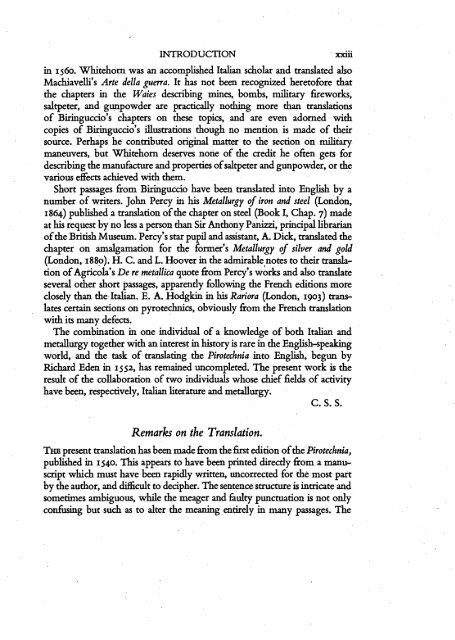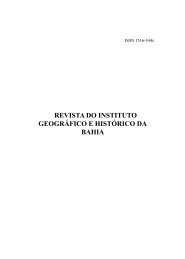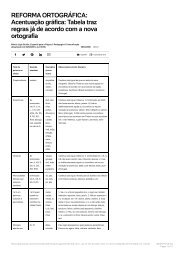Livro - Biringuccio - 09-1002-0
Artilharia os primórdios
Artilharia os primórdios
You also want an ePaper? Increase the reach of your titles
YUMPU automatically turns print PDFs into web optimized ePapers that Google loves.
INTRODUCTION<br />
zariii<br />
in 1560. Whitehorn was an accomplished Italian scholar and translated also<br />
Machiavelli's Arte della guerra. It has not been recognized heretofore that<br />
the chapters in the Waies describing mines, bombs, military fireworks,<br />
saltpeter, and gunpowder are practically nothing more than translations<br />
of <strong>Biringuccio</strong>'s chapters on these topics, and are even adorned with<br />
copies of <strong>Biringuccio</strong>'s illustrations though no mention is made of their<br />
source. Perhaps he contributed original matter to the section on military<br />
maneuvers, but Whitehorn deserves none of the credit he ofien gets for<br />
describing the manufacture and properties of saltpeter and gunpowder, or the<br />
various effects achieved with them.<br />
Short passages fiom <strong>Biringuccio</strong> have been translated into English by a<br />
number of writers. John Percy in his Metallurgy of iron and steel (London,<br />
1864) published a translation of the chapter on steel (Book I, Chap. 7) made<br />
at his request by no less a person than Sir Anthony Panizzi, principal librarian<br />
of the British Museum. Percy's star pupil and assistant, A. Dick, translated the<br />
chapter on amalgamation for the former's Metallurgy of silver and gold<br />
(London, 1880). H. C. and L. Hoover in the admirable notes to their translation<br />
of ~~ricbla's De re metallica quote from Percy's wbrks and also translate<br />
several other short passages, apparently following the French editions more<br />
closely than the Italian. E. A. Hodgkin in his Rariora (London, 1903) translates<br />
certain sections on pyrotechnics, obviously from the French translation<br />
with its many defects.<br />
The combination in one individual of a knowledge of both Italian and<br />
metallurgy together with an interest in history is rare in the English-speakmg<br />
world, and the task of translating the Pirotechnia into English, begun by<br />
Richard Eden in 1552, has remained uncompleted. The present work is the<br />
result of the collaboration of two individuals whose chief fields of activity<br />
have been, respectively, Italian literature and metallurgy.<br />
C. S. S.<br />
Remarks on the Translation.<br />
THE present translation has been made fiom the first edition of the Pirotechma,<br />
published in 1540. This appears to have been printed directly from a manuscript<br />
which must have been rapidly written, uncorrected for the most part<br />
by the author, and difKcult to decipher. The sentence structure is intricate and<br />
sometimes ambiguous, while the meager and kulty punctuation is not only<br />
confking but such as to alter the meaning entirely in many passages. The




![[Cortar & Editat] Artigo - BOXER, C.R - Portuguese Roteiros, 1500-1700_removed](https://documents.yumpu.com/000/065/314/939/2e145b8f9d020cb1478f6bb669de4b853369b67c/6e4a3773446b6e5073444a31584c575877512f4453673d3d/79416d746a45764d6c746a757456566f3043414958413d3d.jpg?AWSAccessKeyId=AKIAICNEWSPSEKTJ5M3Q&Expires=1714392000&Signature=z2whbWlid63pLJwmb%2FDWCmfNS%2BY%3D)
![[Capa & Editar] Artigo - BARROS, Sigrid Porto de - A](https://documents.yumpu.com/000/063/816/786/af709ce29d1c721e5f74c145faeb760c1556c101/714f48715a616a2f324a556f537178394e6b4b4f54413d3d/45394b5a5354347734556b4a575634636c39565037413d3d.jpg?AWSAccessKeyId=AKIAICNEWSPSEKTJ5M3Q&Expires=1714392000&Signature=mXwYIflpKHFrVo%2FBc06KSim%2FKbQ%3D)


